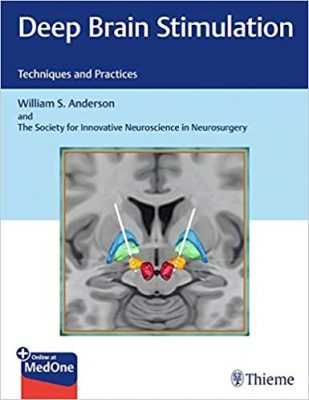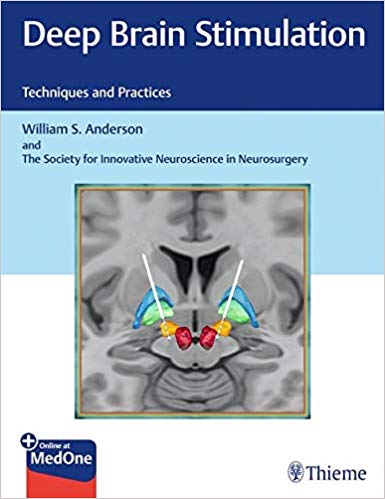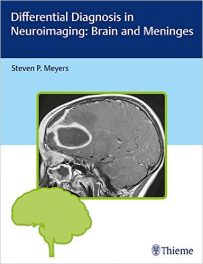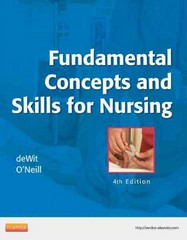 Editors: William S. Anderson, MD and The Society for Innovative Neuroscience in Neurosurgery
Editors: William S. Anderson, MD and The Society for Innovative Neuroscience in Neurosurgery
Publisher: Thieme – 175 pages
Book Review by: Nano Khilnani
This book has been written primarily for neurosurgical residents, functional neurosurgery fellows, and new deep brain stimulation (DBS) practitioners
Movement disorders and other conditions are increasingly being treated with deep brain stimulation (DBS) by neurosurgeons such as the editor Dr. William Anderson who along with six other colleagues are founding members of the Society for Innovative Neuroscience in Neurosurgery. They describe themselves as a small group of ‘passionate’ neurosurgeons rapidly changing the DBS field.
It is a highly technologically-dependent field in which the following techniques are being increasingly used for diagnosis and treatment including surgery:
- Intra-operative image-guided lead-placement techniques
- Utilization of computed tomography or CT or magnetic resonance imaging (MRI) in patients under general anesthesia
- Lesioning techniques in the treatment of essential tremor in adults and dystonia in children
- MR-guided, focused ultrasound treatment
These experts, along with others numbering 46 specialists in neurosurgery and related fields in neuroscience – from all around the United States, and one from Canada – authored the 18 chapters of this book. We list below as an overview for you on the contents of this book:
- Introduction to Deep Brain Stimulation: History, Techniques, and Ethical Considerations
- Customized Platform-Based Stereotactic DBS Lead Placement Technique (FHC STarfix, Medtronic Nexframe, and Robotic System Placement)
- Microelectrode Recording Methods
- Intra-operative Imaging-Based Lead Implantation
- Lesioning Methods for Movement Disorders
- Computational Modeling and Tractography for DBS Targeting
- Closed-Loop Stimulation Methods: Current Practice and Future Promise
- Parkinson’s Disease Application
- Essential Tremor Application
- Deep Brain Stimulation for Dystonia – Clinical Review and Surgical Considerations
- Deep Brain Stimulation for Obsessive Compulsive Disorder
- Deep Brain Stimulation in Epilepsy
- Deep Brain Stimulation in Major Depression
- Deep Brain Stimulation in Tourette Syndrome
- Deep Brain Stimulation in Emerging Psychiatric Indications
- Intraoperative Research During Deep Brain Stimulation Surgery
- Deep Brain Stimulation: Techniques and Practice for Pediatrics Indications
- Establishing a Deep Brain Stimulation Practice
Additional information is available to you when you register your copy of this textbook online. Go to:www.MedOne.Thieme.com/9781626233317. Input the access code found by scratching off the film found on the inside front cover of this book, or scan the QR code found there.
A lot of details are provided in the highly systematic organization of the chapters of this book. This is evident from the first chapter itself entitled Introduction to Deep Brain Stimulation: History, Techniques and Ethical Consideration.
All chapters begin with a short Abstract and a Background or an Introduction that prepares the reader with what to expect going further. In chapter 1, what follows the Introduction are the discussions of the following topics:
- A History of Deep Brain Stimulation
- Ablative Procedures
- Operative Techniques (followed by subtopics on alternative choices of procedures and their respective advantages and disadvantages; descriptions of each procedure and equipment-placement techniques and required preparations)
- Multidisciplinary Committees
- Ethics
- Conclusion
- References
This is an excellent book on deep brain stimulation, with descriptions of current techniques used in treatment of patients that have a number of neurological disorders and conditions that are treatable with DBS. It is highly authoritative, with contributions from many experts in this field. This is a must-have resource, with online assets as well, for anyone planning to get into or is already in neurosurgery.







